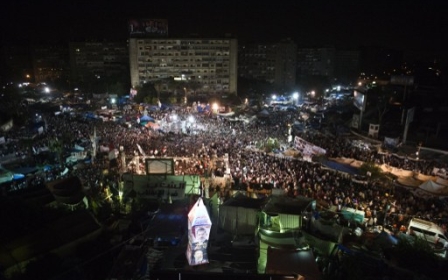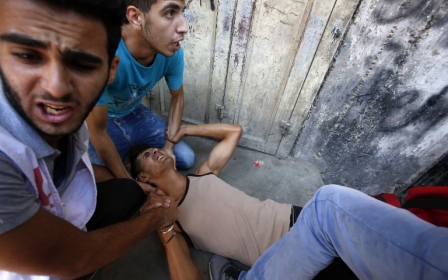Why one-sided reporting on Syria harbours big dangers

There is no such thing as “objective" journalism. Most journalists and analysts would agree on that. Instead, coverage can be compared with the process of taking a photo: you choose the frame, the exposure, the time, the place, and the perspective. Similarly, every individual has his or her own background that determines what shape the resulting coverage will have. Of course, emotions play a vital role in this. Or don’t they?
In the case of Syria, Western coverage gives a voice to the people who live in areas controlled by the various rebel factions and the Islamic State group in the first place. Over four weeks, I collected data on 15 well-known websites that cover the Syrian war and are frequently referred to. My goal was to find out how people in different parts of the country were being covered.
More than 90 percent of the published news, analysis and articles ... focused either on Islamic State or rebel-held territory
More than 90 percent of the published news, analysis and articles that did not deal with international diplomacy focused either on IS or rebel-held territory. They described what life is like in the caliphate, how the Jihadists execute civilians, how President Bashar al-Assad’s air force has been joined by the Russians to bomb residential neighborhoods and how badly countless people in besieged areas suffer.
One could say that the fate of those people is not visible enough, as the “international community“ is shockingly idle given the ongoing slaughter that so far has claimed more than 300,000 lives and displaced more than half of Syria’s population. Thus, it is proper and important to put a spotlight on that misery.
On the other hand, the people who live in areas that are controlled by President Assad’s regime and his allies remain invisible to the greatest possible extent. Some prominent Western journalists who visited Damascus painted an image of a city that is aware of the ongoing conflict but does business as usual. This, however, is not the whole picture. Those who live in regime territory do suffer - not only from the fear of war but also from the forced recruitments, the omnipresent police state and Syria’s dramatic economic situation.
The people who live in areas that are controlled by President Assad’s regime and his allies remain invisible to the greatest possible extent
One of the reasons for the imbalanced reporting might be that there is more extensive information from opposition and even IS territory that reaches the West than there is from regime areas. Due to the high number of sources, a more authentic picture can be drawn by journalists and analysts. That picture, however, is shaped by their own emotions that consciously and unconsciously influence their work.
Furthermore, the journalist's emotional involvement has an impact on what is left out as much as what is reported. Based on that assumption, the question of how central emotions can and possibly should be in the context of journalistic work rises. For this purpose I talked to several contributors.
The problem of over-identification and avoidance
"There's a big difference between my work opinions and my personal opinions. Personally, I find some of the stories/pictures/experiences from Syria to be horrendous. And I do get upset and frustrated, particularly by especially nasty stories. But in my work, I'm immune," one senior lecturer told me on condition of anonymity. This take is representative for the first reaction of most of my interviewees.
The continuous confrontation with pictures and footage of violence can be almost as unsettling as being personally present when violence occurs
However, they also said that the idea of total objectivity is an illusion. Empathic strain affects both the individual and his or her work. One could argue that at least those who never set foot in Syria are not affected. Yet the continuous confrontation with pictures and footage of violence can be almost as unsettling as being personally present when violence occurs. "It is without a doubt that the permanent witnessing of violence and injustice can lead to considerable psychological stress, especially if there is no chance to interfere," a psychologist told me.
Regarding empathic strain, psychologists Wilson and Lindy distinguish between two types of counter-transference, that is, how an individual reacts to the confrontation with atrocities: over-identification and avoidance.
While over-identification results in over-involvement and unmodulated feelings, avoidance results in a "blank screen" facade, intellectualisation and misperception of dynamics. Obviously, both types of reaction have an adverse effect on high-quality reporting and analysis.
Effects on reporting
"I know I need to be objective, but more recently I've started to wonder if I should let emotion into my research more," the lecturer told me, highlighting the aspects mentioned above. "I feel like maybe I have become too detached. Do I risk not capturing the full story and implications of an event if I don't allow my emotions into my analysis?"
Over-identification and avoidance can be understood as two poles of a wide emotional spectrum. While emotional reactions per se are not problematic and part of human nature, a problem arises when the journalist shifts too far in one direction. Over-identification could, for instance, result in the recommendation of direct Western military intervention in Syria to stop the air strikes immediately, without considering the long-term effects of such a move. Avoidance, on the other hand, could lead to the recommendation of staying out completely as a consequence of the experience with the bloody intervention in neighbouring Iraq.
Even if their critical coverage of the atrocities that have been commited by the Assad regime and its allies might be well-founded, many readers will be sceptical
However, it is not only about implicit and explicit recommendations but also about the best possible objective standpoint that readers legitimately expect. Over-identification potentially leads to sympathy for one side. Journalists, for instance, who portray Syria’s armed opposition as a people’s rebellion without mentioning both the international dimension as well as the fact that the rebels are dominated by certain militant groups, can appear overly sympathetic towards the armed opposition. This in turn leads to readers suspecting a bias. Even if their critical coverage of the atrocities that have been commited by the Assad regime and its allies might be well-founded, many readers will be sceptical.
As the above quotes indicate, journalists and analysts are possibly more afraid of over-identification or over-involvement and therefore have a tendency to avoidance or neglect. This might have to do with the fact that emotions are typically taboo in the field of journalism. But as many examples of successful journalists show, it is certainly possible and helpful to reflect on one‘s emotions instead of losing oneself in them or avoiding them altogether.
For the work of journalists and analysts it would be constructive to conduct an open discourse that recognises the emotional impact of atrocities in general and enables learning from colleagues who are experienced in actively engaging with their emotions. Such a taboo-breaking discourse could ultimately help journalists reflecting on the impact of their own emotions, which would likely improve their work.
The risk of one-sided reporting, even if unintentional
One essential question is whom the Syria coverage makes visible. Whom does it give a voice in the particular media landscape and its recipients? There are various reasons for the dominance of coverage on the atrocities in opposition-held territory. For instance, the exerted pressure of editors: "If it bleeds, it leads…" as one journalist told me. Sadly, there is so much blood in hotspots like Aleppo and around Damascus and so much cruelty in IS-held areas that headlines produce themselves without much aid from reporters' own biases.
But another important reason is the emotional involvement of the contributors - those who shape the headlines and determine the Western discourse. Presence in media is a zero-sum game: the overrepresentation of opposition-held areas goes hand in hand with the underrepresentation of regime-controlled territory.
Millions of Syrians who live in opposition-held territory won’t forget that "the world“ stood idly by while they were being slaughtered.
The effects of this are potentially troublesome. Millions of Syrians living in opposition-held territory won’t forget that "the world“ stood idly by while they were being slaughtered. Similarly, millions of Syrians who live in regime territory won’t forget how they had no voice and how their suffering remained largely invisible. This is an utterly unfavourable premise for reconciliation between people who have to find a way to shape their future, if not in the same country then at least in the immediate vicinity.
Furthermore, it strengthens the position of President Assad and his regime: "They [Western media] only speak about bombardment by our air force. But we are targeted as well! I love Bashar, he is the only one who can protect us from extremists,“ one Sunni from a wealthy family that had good connections to regime officials, told me.
The regime’s strategy is to present itself as the only chance for the survival of Syria’s minorities and those who have ties to the regime. When those groups feel that they do not have any chance of a voice elsewhere, it will surely fortify their conviction to support the president.
Note: See Countertransference in the Treatment of PTSD. Edited by John P Wilson and Jacob D Lindy, Guilford Press, 1994.
- Lars Hauch studied International Development in Vienna and worked as head of editorial at the German media outlet Commentarist. With a focus on the MENA region, he published a commented roundup www.menaroundup.com, in addition to writing for EAWorldview and the German CARTA.
The views expressed in this article belong to the author and do not necessarily reflect the editorial policy of Middle East Eye.
Photo: Syrian civilians from the town of Daraya prepare to be evacuated from the rebel-held town of Moadamiyet al-Sham on September 2, 2016 to be taken to a shelter in the government-controlled town of Hrajela. (AFP)
This article is available in French on Middle East Eye French edition.
New MEE newsletter: Jerusalem Dispatch
Sign up to get the latest insights and analysis on Israel-Palestine, alongside Turkey Unpacked and other MEE newsletters
Middle East Eye delivers independent and unrivalled coverage and analysis of the Middle East, North Africa and beyond. To learn more about republishing this content and the associated fees, please fill out this form. More about MEE can be found here.





